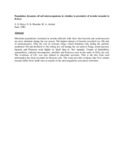| dc.description.abstract | Microbial populations estimated in termite-affected soils show that bacteria and actinomycetes are most abundant during the wet season. The highest density of bacteria recorded was 106 and, of actinomycetes, 105g dry soil. In contrast, fungi, which dominate only during dry periods, numbered 104 and declined to 102 cells/g dry soil during the
wet period. Fungi, actinomycetes, bacteria and Protozoa were higher in 'dead' than in 'live' mounds. Counts of denitrifiers, ammonifiers, cellulose decomposers, nitrifiers and Protozoa were in the order of 103/g dry soil. The evolution of CO, was also related to microbial activities. This is the first time such information has been recorded for Kenyan
soils. The study provides evidence that 'live' termite mounds differ from 'dead' ones in respect of the microorganisms associated with them. | en |

